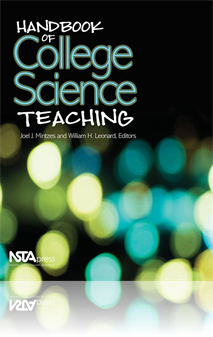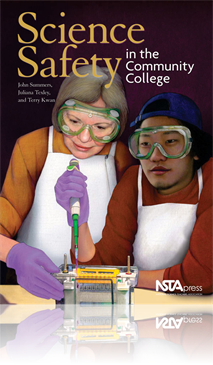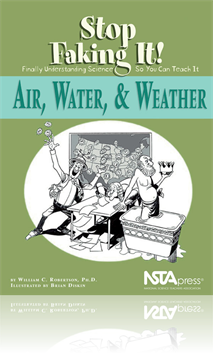All Book Chapters
Book Chapter
Converting Your Lab from Verification to Inquiry
This chapter offers insight into how to create laboratories that provide students with research experiences within the constraints of time, resources, and course formats that most faculty face. It provides a research-based rationale for investigative...
Book Chapter
Technology-Enriched Learning Environments in University Chemistry
Science and technology courses in higher education have traditionally been composed of three elements—lecture, recitation, and evaluation—and have been conducted in lecture-based, teacher-centered settings. In recent years, a growing number of un...
Book Chapter
Animations (rapidly changing sequences of drawn objects that simulate motion as in a movie) have been advocated for classroom use for years (Hall 1996), and there is good evidence to support the value of this practice. However, there is general agree...
Book Chapter
Instructional Technology: A Review of Research and Recommendations for Use
Carefully chosen and properly used instructional technology can increase student learning and student interest. Poorly used instructional technology can do the opposite; we have all experienced this phenomenon when victimized by an enthusiastic new P...
Book Chapter
Web-Based Practice and Assessment Systems in Science
In this chapter the authors describe the specific kinds of items that they have developed for use in automated practice systems and discuss some issues related to web-based learning. Next, they describe in broad terms other web implementations. They ...
Book Chapter
Teaching Students to Evaluate the Accuracy of Science Information on the Internet
This chapter addresses the issue of variable accuracy of science information on the internet, how to address this topic in undergraduate science courses, how to make students aware of this situation (if they are not already), and how to begin to trai...
Book Chapter
Science, Technology, and the Learning Disabled: A Review of the Literature
The lack of research studies that examine the use of technology as a tool to support the learning of science among the learning disabled is an important limitation of research in science teaching....
Book Chapter
Diversity in the Physical Science Curriculum: The Intellectual Challenge
In this chapter, the author argues that integrating science with the real and pressing concerns of human beings on this planet is a powerful way to give race, ethnicity, class, and gender a rightful place in our science classrooms. In the process, we...
Book Chapter
Incorporating Cultural Diversity Into College Science
Due to the globalization of world economics, advances in information technologies, and the complex interconnections of global environmental issues, postsecondary institutions recognize the growing importance of offering courses about other cultures a...
Book Chapter
Motivation to Learn in College Science
All college science teachers share the important goal of motivating college students to learn science. In this chapter, the authors discuss motivational theory and research in college teaching and draw implications for effective practices. They also ...
Book Chapter
Applying Conceptual Change Strategies to College Science Teaching
This chapter will focus on meaningful learning and conceptual change from the perspective of science education. The authors describe in detail two case studies of conceptual change-based curricula—one that focuses on the particulate nature of matte...
Book Chapter
Ensuring That College Graduates Are Science Literate: Implications of K-12 Benchmarks and Standards
This chapter draws on some fundamental lessons learned about science teaching and learning at the K—12 level that are likely to be applicable to a higher-education context. Recommendations are made in three areas that seem especially important to i...
Book Chapter
The High-School-to-College Transition in Science
It is important to remember the variety of competing events and pressures that first-year students face while adjusting to a different life in college. Science faculty need to understand why some students struggle during their first year so that facu...
Book Chapter
Factors Influencing Success in Introductory College Science
Studies on the influence of pre-college factors on success in college science are well established. Most studies have been carried out in single institutions (e.g., Alters 1995; Hart and Cottle 1993), with only a few collecting samples from multiple ...
Book Chapter
Assessment Practices in College Science: Trends From the National Study of Post-Secondary Faculty
The trend toward using performance-based or authentic assessment is evident at K—12 levels of schooling (Stiggins 1991) but less evident in college science teaching. Therefore, this study used the National Study of Postsecondary Faculty (NSOPF), sp...
Book Chapter
Making Choices About Teaching and Learning in Science
What exactly do we mean by civic engagement? Does it imply a way of thinking about knowledge in a democratic society? Or does it require personal action in a civic context? For the readers of this handbook, what relevance does civic education have fo...
Book Chapter
Science and Civic Engagement: Changing Perspectives from Dewey to DotNets
A prominent theme in current discourse about U.S. higher education is the goal of "civic" education. In this chapter, the author explores three related perspectives on civic engagement. First, he examines how John Dewey viewed the relationship betwee...
Book Chapter
Using Research on Teaching to Improve Student Learning
This chapter describes general procedures for research on college and university science teaching, examples and benefits of several very different research models that can be used, examples of published studies, and suggestions on how to get your res...
Book Chapter
Experiential Learning in a Large Introductory Biology Course
This chapter describes and discusses effective approaches to teaching a large, two-semester introductory college biology course at Syracuse University. The course offers many unusual and creative experiences that enhance student learning and create a...
Book Chapter
Strategies for Interactive Engagement in Large Lecture Science Survey Classes
This chapter describes some things that faculty in large-enrollment introductory astronomy courses do to intellectually engage students in learning the material during class time. These strategies are easily transferable to other scientific disciplin...
Book Chapter
Undergraduate Research in Science: Not Just for Scientists Anymore
Institutional measures, such as the fraction of undergraduate research (UR) students who later pursue a PhD in science, do not reflect the value of UR as an educational and personal growth experience for students; moreover, little data exist to justi...
Book Chapter
Concept Mapping in College Science
A concept map is a two-dimensional, hierarchical node-link diagram that depicts the most important concepts and propositions in a knowledge domain. Concept mapping helps students and faculty recognize the difference between meaningful and rote learni...
Book Chapter
Peer Instruction: Making Science Engaging
Peer Instruction (PI) is an interactive approach that was designed to improve the learning process. This approach provides students with greater opportunity for synthesizing the concepts while instructors get timely feedback that can help focus the i...
Book Chapter
Open Laboratories in College Science
One viable alternative to the conventional, regularly scheduled laboratory session is the open laboratory concept. In this chapter, the authors use the open laboratory system developed at Eastern Kentucky University as a case study to provide insight...
Book Chapter
Setting the Scene: Safer Science in a Drive-Through Learning Community
Developing a responsible and safe introductory community college laboratory science program is a challenge. The subject matter is complex, requiring cerebral, technical, and mechanical skills. The prior knowledge and experiences of students are diver...
Book Chapter
The Kitchen Sink: A Potpourri of Teaching Tips
The 21st century has brought new technology as well as new concerns. After covering traditional safety categories in previous chapters, this chapter discusses items that fit nowhere else, such as internet use, allergies, and Standard (Universal) Prec...
Book Chapter
Live Long and Prosper: And Remember You Are Responsible
Today's society is quite litigious, and many people place blame on instructors for factors well beyond the instructors' control. This chapter shares tips on how professionals can "Live Long and Prosper" by protecting themselves as well as their stude...
Book Chapter
Communities of Learners: Promoting Science for Every Citizen
This chapter looks at ways to accommodate diverse needs and goals—not only to make a program safer but also to help everyone involved achieve the goals that brought them to the community college campus. A number of resources are listed at the end o...
Book Chapter
Where Science Happens: Equip Your Lab for Safety
Many college buildings are aging and with increases in enrollment, some administrators are forced to use stopgap scheduling or emergency housing. This chapter discusses space and equipment, while highlighting the importance of facilities and how they...
Book Chapter
Finders Keepers: Essentials of Safer Storage
More than any other community college instructional disciplines, laboratory sciences require safe and secure storage facilities. This includes storage within the classroom/lab, as well as dedicated storage areas adjacent to but separate from the clas...
Book Chapter
Lively Science: Living Organisms and More
Most life science laboratories are filled with chemicals and electronics. Observing and studying living organisms is critical to a strong program, but living organisms need to be maintained in a safe and educationally sound manner. This chapter summa...
Book Chapter
Modern Alchemy: Safer Teaching With Chemistry
Today more students take chemistry at the secondary level than a decade ago, but community college instructors must not assume that these students come with the same knowledge and laboratory skills as students arriving even five years ago. Instructor...
Book Chapter
Falling for Science: Physics Phenoms
The knowledge and experience of students in "typical" introductory college physics is far more diverse than it once was. Instructors have to adjust teaching methods and safety instruction to ensure full and safe participation by all. This chapter sum...
Book Chapter
The Great Outdoors: Field Studies Near and Far
With any outing—entire class or a few students—the difference between success and failure and between a safe, memorable learning experience and disaster is careful planning and preparation. This chapter includes tips for field studies and explori...
Book Chapter
If you understood the first two chapters, you now know how to describe motion (using velocity and accelerations) and you know what causes changes in motion (net forces do it). Remember that net force refers to what you get when you consider the tota...
Book Chapter
The contents of this chapter deal with air pressure and water pressure and what causes those things to increase and decrease. In addition, the real-world results of those increases and decreases in air and water pressure will be addressed....
Book Chapter
This chapter delves deeper into air pressure, or to be more correct, the pressure exerted by any gas. The most important part of this chapter is a scientific model for how gases behave, which will be used to explain previous activities pertaining to ...
Book Chapter
Balloons and Other Things That Sometimes Float
Hot air balloons float--sometimes. Regular old balloons that you get at a party float--sometimes. Boats float--sometimes. What makes them float and what makes them sink? How can a boat made of steel float but a solid chunk of steel sink to the bottom...
Book Chapter
Before moving on to weather patterns, there are a few concepts about air and water that haven't been covered thus far. This chapter ties together these loose ends and prepares readers for a better understanding of the various processes that cause wea...
Book Chapter
The concepts covered so far that pertain to the Earth's weather will finally be applied in this chapter. A number of basic mechanisms that govern small-scale things such as cloud formation, rain, fog, dew point, and humidity, will be addressed. ...






